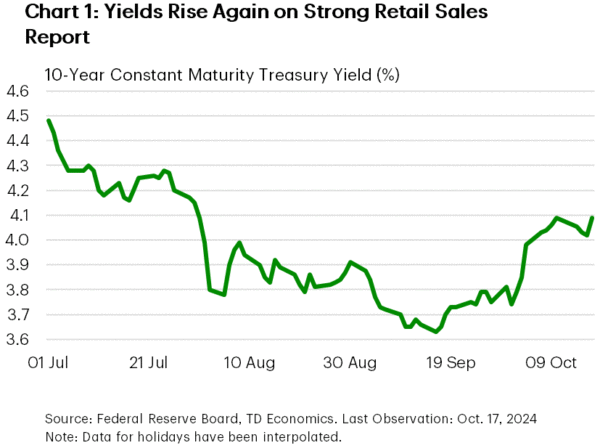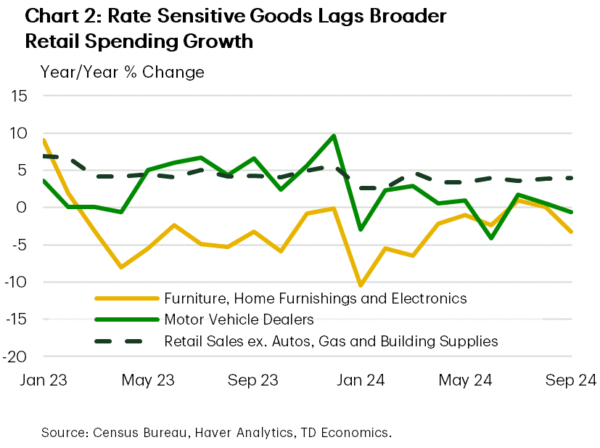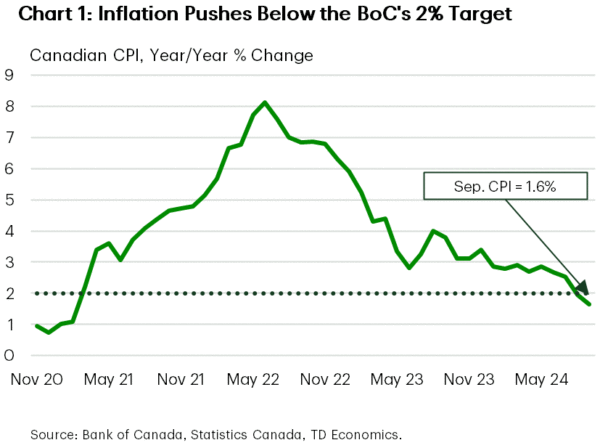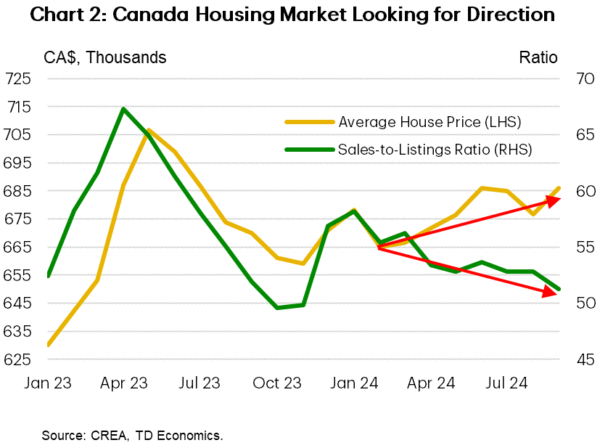U.S. Highlights
- The retail sales report once again reinforced the message that the U.S. consumer continues to brush off headwinds.
- Personal income growth, some remaining pandemic savings, and a healthy labor market should help to support trend-like growth in personal consumption expenditures into early 2025.
- A still healthy labor market, and a commitment to data dependency means a measured and deliberate approach to interest rate reductions.
Canadian Highlights
- Canadian inflation made headlines this week with a big downwards move, pushing below the central bank’s 2% target.
- The housing market is starting to stir, with resale activity jumping in September. At the same time, listings have surged, as sellers test out the market following nearly two years of housing market uncertainty.
- The easing in inflation has raised odds that the BoC follows the Fed with an outsized 50 basis point cut at its policy meeting next week.
U.S. – Slow and Steady
U.S. Treasury yields were on the rise again this week (Chart 1) as a brighter picture of the consumer pared back rate cut bets. The September retail sales report once again reinforced the message that the consumer continues to plow ahead, brushing off headwinds from higher rates and two years’ worth of rapid cost-of-living increases. Policymakers and markets continue to assess that interest rates need to fall further, but the timing and level of where they ultimately land remains hotly debated.
Data are streaming in and showing consumers, the backbone of the U.S. economy, are willing and able to spend on goods and services at a healthy pace. Retail sales figures for September rose 0.4% month-on-month, beating out economists’ expectations. Moreover, the “control group” of less volatile expenditure categories surged 0.7% for the month as spending on clothing, personal care and miscellaneous goods surged. With stronger than expected economic news, bond yields surged, rising 6 basis points (bps) through Thursday’s close.
The print suggests plenty of momentum in consumption expenditures into the third quarter, providing a fillip to GDP growth. However, strong doesn’t mean that monetary policy isn’t exerting pressure on households. Sales of motor vehicle dealers were down marginally, as were expenditures on furniture and electronics stores (Chart 2). These categories of goods are more interest rate sensitive, leaving them most susceptible to the still elevated interest rate environment.
However, as we noted this week, the recent upward revision to personal income means households are still holding excess savings that can be deployed. While the funds are mostly concentrated among higher income households that are less likely to spend, their availability means that demand for durable goods could rise as interest rates slowly fall. This sentiment was echoed by Fed Governor Waller this week, when he noted that his “business contacts believe that there is considerable pent-up demand for durable goods, home improvements and other big-ticket items”.
While the labor market is gradually rebalancing, personal income growth is still robust and some remaining pandemic savings should help to support trend-like growth in personal consumption expenditures into early 2025. Carefully balancing strong growth and a healthy labor market against the risks of a flare-up in inflation will likely leave the Fed adopting a relatively cautious and data dependent approach to interest rates – caution Governor Waller reiterated stating, “monetary policy should proceed with more caution on the pace of rate cuts than was needed at the September meeting.”
Policy remains highly restrictive, and more easing is on the way. A still healthy labor market, and a commitment to data dependency means a measured and deliberate approach to policy. This leaves us thinking the Fed will deliver two more quarter point cuts through 2024.
Canada – Canadian Inflation Drops Below Target
It was a busy data week ahead of the Bank of Canada’s (BoC) upcoming policy meeting. Canadian Consumer Price Index (CPI) inflation made headlines with a big downwards move in September, pushing below the central bank’s 2% target (Chart 1). We also got another reading on the housing market, which is starting to show signs of life in response to recent rate cuts. Financial markets have responded, pricing a higher likelihood that the BoC will swing for a larger 50 bp cut.
Headline inflation clocked in at 1.6% year-on-year (y/y) in September, reaching below the central bank’s target for the first time since early 2021. While this drop was expected given September’s 7% monthly drop in gasoline prices, it speaks to the impact of the central bank’s hiking cycle on the Canadian economy. The interest sensitive goods category is firmly in deflation at -1% y/y, whereas inflation excluding the impact of shelter prices is running at just 0.4% y/y.
In terms of core inflation, the average of the BoC’s two metrics is holding steady at 2.4% y/y. Encouragingly, the three-month annualized pace of core eased to 2.1% (from 2.3% in August). This points to further improvement in the annual pace of core inflation in the coming months. Further adding to this narrative is the fact that other measures of core inflation – CPI excluding food and energy and the BoC’s old core measure (CPIX) – are sitting at 1.6% on a three-month basis. This cements the need for more rate cuts.
The biggest beneficiary from the BoC’s easing cycle is typically the housing market. While the market response to rate cuts hasn’t come to a boil like many would have expected, it is starting to stir. Housing sales jumped nearly 2% in September and are up 6% since rate cuts started in June. But at the same time, listings are up over 9%, as sellers test out the market following nearly two years of housing market uncertainty. This has the sales-to-listings ratio on the decline, which has limited the potential acceleration in house price growth (Chart 2). We expect this to give way in the coming months once the recent wave of listings has been cleared. This should jolt the housing market, pushing sales and prices higher.
That brings us to the BoC’s policy decision next week. The bank has executed three straight cuts of 25 bps, highlighting the need to help economic growth reaccelerate and avoid a hard landing. The argument for a 25 bp cut is that there is still clear strength coming from the jobs market, with wage growth running well above inflation. This will support consumer spending, which we think is starting to accelerate heading into the holiday shopping season. Now, the case for a 50 bp move is coming from the fact that Q3 GDP growth is tracking well below the BoC’s forecast (even if it should rebound in Q4) and headline inflation is below target. The central bank will have to downgrade its forecast for both on Wednesday and can use this as cover to justify a 50. Despite market pricing shifting towards 50 bps, we still think 25 bps is the right move given the arguments above. Next week’s decision is turning out to be a nail biter, but either way, rates will continue to head lower.


















